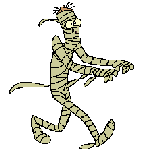 Mummies in Ireland
Mummies in Ireland
When you think of mummies you are automatically drawn to places like the British Museum, the Louvre and of course Egypt itself. Although Ireland would not readily spring to mind, I am happy to report that we can boast of a small but fine collection in a number of locations throughout the country.
Perhaps the most enigmatic mummy in Ireland is in the Boole Library in University College Cork. The college records provide no clue as to how the mummy came to rest in UCC, although there are a number of possible donors. The mummy is male, and his name was Osiris Pa - Khnum, son of Tkmy. His anthropoid mummiform coffin depicts the procession to the tomb, and the jackal headed god Anubis is shown mummifying the dead man. These scenes are painted in polychrome. The coffin is inscribed with texts from the Book of the Dead in hieroglyphs, which are written both vertically and horizontally.
Inside, the long side walls of the coffin have paintings which depict the divine protectresses Isis and Nephthys, sisters of Osiris. The head board has uraei (cobras) and sun-disk, and the footboard also has a sun-disk. A 'devolved cartonnage
# case' in four sections covers the mummy from head to toe. This is of course linen and brightly painted. The face mask has a papyrus base, is gilded, and over-painted with facial features. Unfortunately, it is in very bad repair. Motifs, mainly geometric, in blue, reddish brown, and white, decorate the pectoral collar, and a stylised representation of the sunrise is the central feature. Lotus flowers and buds decorate the curved edge. The ovoid covering of the lower body depicts the Ka (soul), in the form of a man-headed hawk, visiting the mummy, and then, in reddish brown, gods and demons of the Underworld, along with a prayer, in hieroglyphs, for the dead: "Hail Osiris Pa-Khnum, son of Tkmy and born of the lady of the house Wy ........ Anubis is come to you". The prayer is concluded on the leg and foot covering, which also depicts two seated jackals in the same colour. Sandals are also painted on the foot covering so that the dead man would not have to walk barefoot in the Underworld.This mummy perhaps dates from between 1070 - 300 BC, which places it between the XXIst Dynasty and the end of the second Persian occupation.
There are also other mummies in Ireland, some in the Belfast Museum and others in the National Museum in Dublin. The later has a particularly fine example from the XXII nd Dynasty of the lady Tjentdinebu, and is in a remarkable state of preservation with brilliantly painted coffin and cartonnage. The Museum now has a fine range of Egyptian artefacts on display and this exhibition was opened back in 1997 (see article on National Museum). These items remained unseen for a long time due to a lack a space.
Other mummies in the National Museum include one of a youth from the Roman period, and a rather macarbre mummy's hand with a ring still on one of the fingers. There are also a number of mummified animals such as some cats, a crocodile, hawks, ibises and the bones
of a jackal.